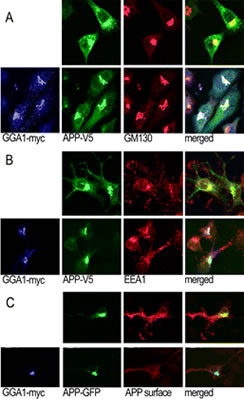GGA1 Antibody (N-term)
Purified Rabbit Polyclonal Antibody (Pab)
- SPECIFICATION
- CITATIONS: 1
- PROTOCOLS
- BACKGROUND

Application
| WB, IF, E |
|---|---|
| Primary Accession | Q9UJY5 |
| Other Accession | Q8R0H9 |
| Reactivity | Human, Mouse |
| Host | Rabbit |
| Clonality | Polyclonal |
| Isotype | Rabbit IgG |
| Calculated MW | 70384 Da |
| Antigen Region | 1-30 aa |
| Gene ID | 26088 |
|---|---|
| Other Names | ADP-ribosylation factor-binding protein GGA1, Gamma-adaptin-related protein 1, Golgi-localized, gamma ear-containing, ARF-binding protein 1, GGA1 |
| Target/Specificity | This GGA1 antibody is generated from rabbits immunized with a KLH conjugated synthetic peptide between 1-30 amino acids from the N-terminal region of human GGA1. |
| Dilution | WB~~1:1000 IF~~1:10~50 E~~Use at an assay dependent concentration. |
| Format | Purified polyclonal antibody supplied in PBS with 0.09% (W/V) sodium azide. This antibody is prepared by Saturated Ammonium Sulfate (SAS) precipitation followed by dialysis against PBS. |
| Storage | Maintain refrigerated at 2-8°C for up to 2 weeks. For long term storage store at -20°C in small aliquots to prevent freeze-thaw cycles. |
| Precautions | GGA1 Antibody (N-term) is for research use only and not for use in diagnostic or therapeutic procedures. |
| Name | GGA1 |
|---|---|
| Function | Plays a role in protein sorting and trafficking between the trans-Golgi network (TGN) and endosomes. Mediates the ARF-dependent recruitment of clathrin to the TGN and binds ubiquitinated proteins and membrane cargo molecules with a cytosolic acidic cluster-dileucine (DXXLL) motif (PubMed:11301005, PubMed:15886016). Mediates export of the GPCR receptor ADRA2B to the cell surface (PubMed:27901063). Required for targeting PKD1:PKD2 complex from the trans-Golgi network to the cilium membrane (By similarity). Regulates retrograde transport of proteins such as phosphorylated form of BACE1 from endosomes to the trans-Golgi network (PubMed:15615712, PubMed:15886016). |
| Cellular Location | Golgi apparatus, trans-Golgi network membrane; Peripheral membrane protein. Endosome membrane; Peripheral membrane protein Early endosome membrane; Peripheral membrane protein |
| Tissue Location | Ubiquitously expressed. |

Provided below are standard protocols that you may find useful for product applications.
Background
GGA1 is a member of the Golgi-localized, gamma adaptin ear-containing, ARF-binding (GGA) protein family. Members of this family are ubiquitous coat proteins that regulate the trafficking of proteins between the trans-Golgi network and the lysosome. These proteins share an amino-terminal VHS domain which mediates sorting of the mannose 6-phosphate receptors at the trans-Golgi network. They also contain a carboxy-terminal region with homology to the ear domain of gamma-adaptins.
References
Zhai, P., et al., Biochemistry 42(47):13901-13908 (2003).
Zhu, G., et al., Biochemistry 42(21):6392-6399 (2003).
Shiba, T., et al., Nat. Struct. Biol. 10(5):386-393 (2003).
Suer, S., et al., Proc. Natl. Acad. Sci. U.S.A. 100(8):4451-4456 (2003).
Shiba, T., et al., Nature 415(6874):937-941 (2002).
If you have used an Abcepta product and would like to share how it has performed, please click on the "Submit Review" button and provide the requested information. Our staff will examine and post your review and contact you if needed.
If you have any additional inquiries please email technical services at tech@abcepta.com.














 Foundational characteristics of cancer include proliferation, angiogenesis, migration, evasion of apoptosis, and cellular immortality. Find key markers for these cellular processes and antibodies to detect them.
Foundational characteristics of cancer include proliferation, angiogenesis, migration, evasion of apoptosis, and cellular immortality. Find key markers for these cellular processes and antibodies to detect them. The SUMOplot™ Analysis Program predicts and scores sumoylation sites in your protein. SUMOylation is a post-translational modification involved in various cellular processes, such as nuclear-cytosolic transport, transcriptional regulation, apoptosis, protein stability, response to stress, and progression through the cell cycle.
The SUMOplot™ Analysis Program predicts and scores sumoylation sites in your protein. SUMOylation is a post-translational modification involved in various cellular processes, such as nuclear-cytosolic transport, transcriptional regulation, apoptosis, protein stability, response to stress, and progression through the cell cycle. The Autophagy Receptor Motif Plotter predicts and scores autophagy receptor binding sites in your protein. Identifying proteins connected to this pathway is critical to understanding the role of autophagy in physiological as well as pathological processes such as development, differentiation, neurodegenerative diseases, stress, infection, and cancer.
The Autophagy Receptor Motif Plotter predicts and scores autophagy receptor binding sites in your protein. Identifying proteins connected to this pathway is critical to understanding the role of autophagy in physiological as well as pathological processes such as development, differentiation, neurodegenerative diseases, stress, infection, and cancer.


